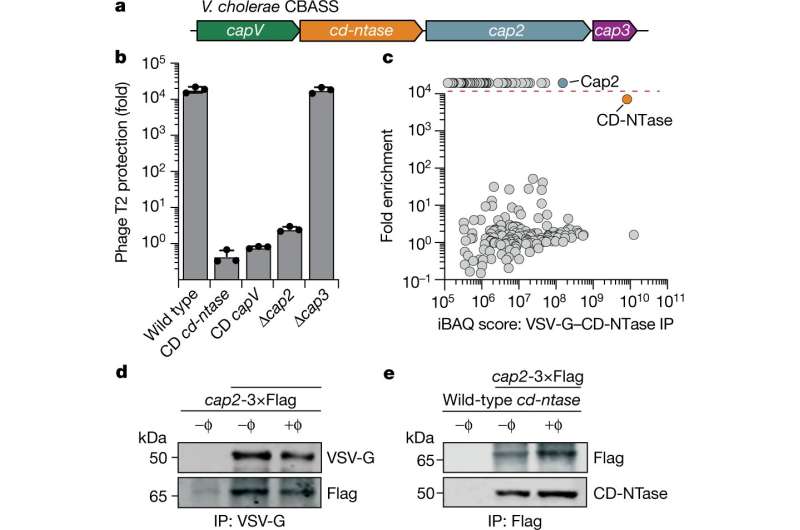This article has been reviewed according to Science X's editorial process and policies. Editors have highlighted the following attributes while ensuring the content's credibility:
fact-checked
peer-reviewed publication
trusted source
proofread
'We're not all that different': Study IDs bacterial weapons that could be harnessed to treat human disease

When it comes to fighting off invaders, bacteria operate in a remarkably similar way to human cells, possessing the same core machinery required to switch immune pathways on and off, according to new University of Colorado Boulder research.
The study, published Feb. 8 in the journal Nature, also sheds light on how that shared, ancient machinery—a cluster of enzymes known as ubiquitin transferases¬—works.
Better understanding, and potentially reprogramming this machine, could ultimately pave the way to novel approaches for treating a host of human diseases, from autoimmune disorders like Rheumatoid arthritis and Crohn's disease to neurodegenerative diseases like Parkinson's disease, the authors said.
"This study demonstrates that we're not all that different from bacteria," said senior author Aaron Whiteley, an assistant professor in the Department of Biochemistry. "We can learn a lot about how the human body works by studying these bacterial processes."
The next CRISPR?
The study is not the first to showcase the lessons bacteria can teach humans.
Mounting evidence suggests that portions of the human immune system may have originated in bacteria, with evolution yielding more complex iterations of bacterial virus-fighting tools across plant and animal kingdoms.
In 2020, University of California Berkeley biochemist Jennifer Doudna won the Nobel Prize for CRISPR, a gene-editing tool that repurposes another obscure system bacteria use to fight off their own viruses, known as phages.
The buzz around CRISPR ignited renewed scientific interest in the role proteins and enzymes play in anti-phage immune response.
"Over the past three to five years people have realized it doesn't end with CRISPR. The potential is so much bigger," said Whiteley.
Missing link in evolutionary history
For the study, Whiteley and co-first author Hannah Ledvina, a Jane Coffin Childs Postdoctoral Fellow in the department, collaborated with University of California San Diego biochemists to learn more about a protein called cGAS (cyclic GMP-AMP synthase), previously shown to be present in both humans and, in a simpler form, bacteria.
In bacteria and in humans, cGAS is critical for mounting a downstream defense when the cell senses a viral invader. But what regulates this process in bacteria was previously unknown.
Using an ultra-high-resolution technique called cryo-electron microscopy alongside other genetic and biochemical experiments, Whiteley's team took an up-close look at the structure of cGAS's evolutionary predecessor in bacteria and discovered additional proteins that bacteria use to help cGAS defend the cell from viral attack.
Specifically, they discovered that bacteria modify their cGAS using a streamlined "all-in-one version" of ubiquitin transferase, a complex collection of enzymes that in humans control immune signaling and other critical cellular processes.
Because bacteria are easier to genetically manipulate and study than human cells, this discovery opens a new world of opportunity for research, said Ledvina.
"The ubiquitin transferases in bacteria are a missing link in our understanding of the evolutionary history of these proteins."
Editing proteins
The study also revealed just how this machine works, identifying two key components—proteins called Cap2 and Cap3 (CD-NTase-associated protein 2 and 3)— which serve, respectively, as on and off switches for the cGAS response.
Whiteley explained that in addition to playing a key role in immune response, ubiquitin in humans can serve as a sort of marker for cellular garbage, directing excess or old proteins to be broken down and destroyed. When that system misfires due to mutations in the machine, proteins can build up and diseases, such as Parkinson's, can occur.
The authors stress that far more research is needed but the discovery opens exciting scientific doors. Just as scientists adapted the ancient bacterial defense system CRISPR into scissor-like biotechnology that can snip mutations out of DNA, Whiteley believes pieces of the bacterial ubiquitin transferase machine—namely Cap3, the "off switch"— could ultimately be programmed to edit out problem proteins and treat disease in humans.
He and his team, with the help of Venture Partners at CU Boulder, have already filed for intellectual property protection, and they're moving forward with more research.
"The more we understand about ubiquitin transferases and how they evolved, the better equipped the scientific community is to target these proteins therapeutically,"Whiteley said. "This study provides really clear evidence that the machines in our body that are important for just maintaining the cell started out in bacteria doing some really exciting things."
More information: Hannah E. Ledvina et al, An E1–E2 fusion protein primes antiviral immune signalling in bacteria, Nature (2023). DOI: 10.1038/s41586-022-05647-4
Journal information: Nature
Provided by University of Colorado at Boulder





















